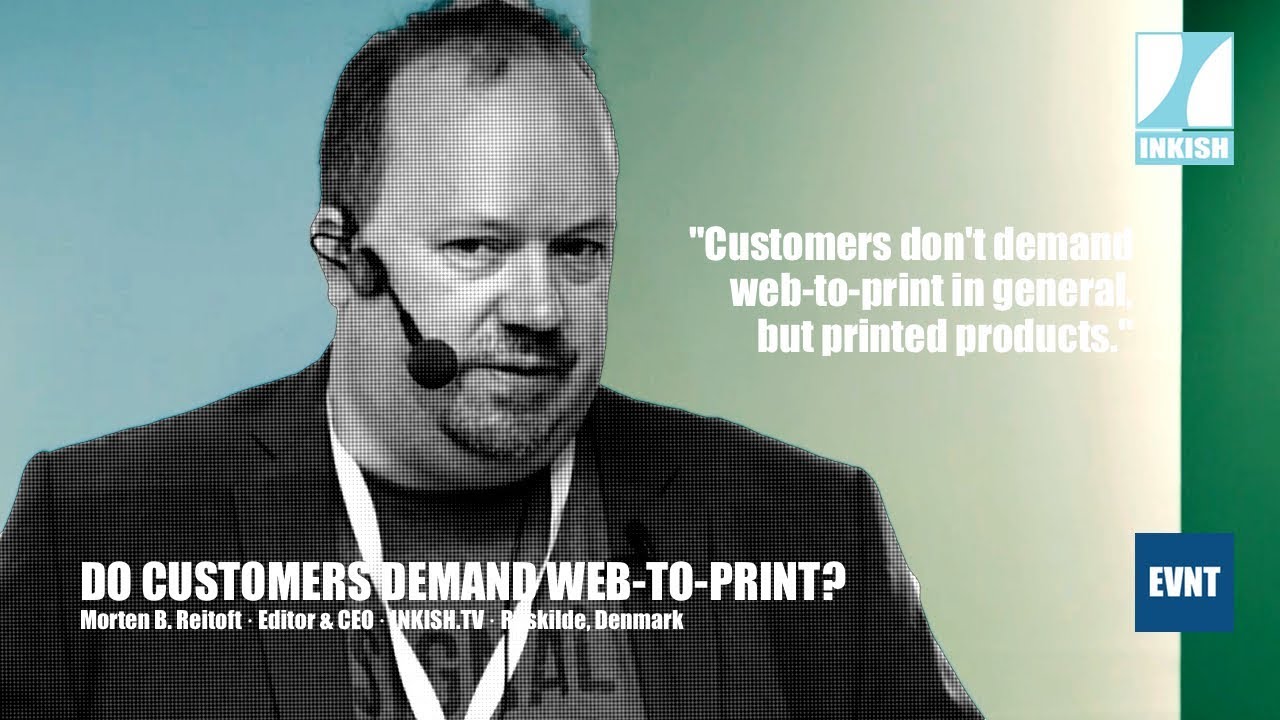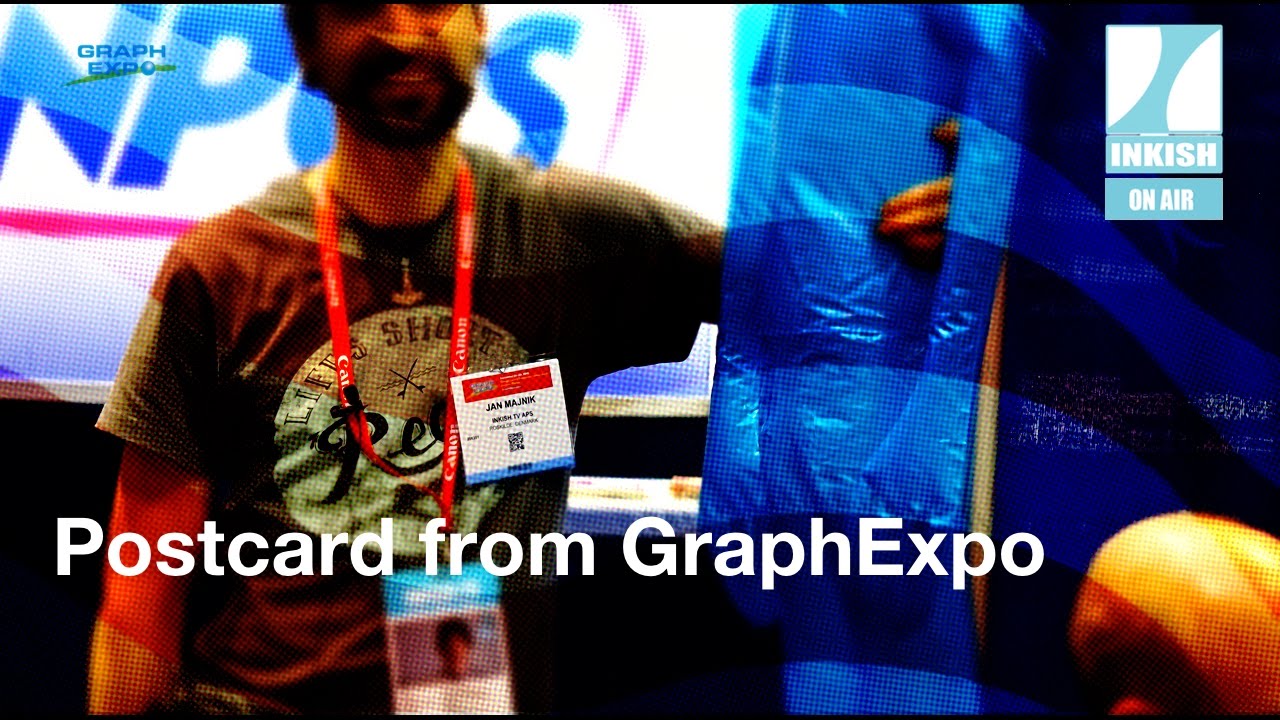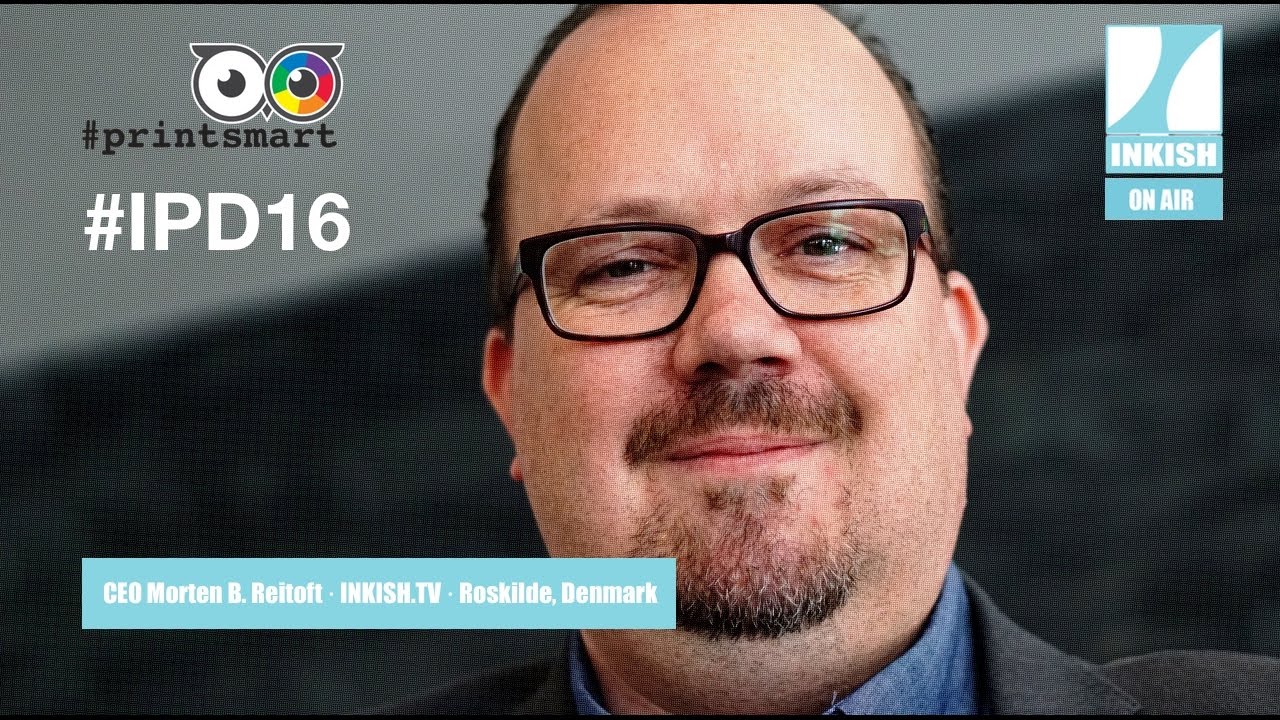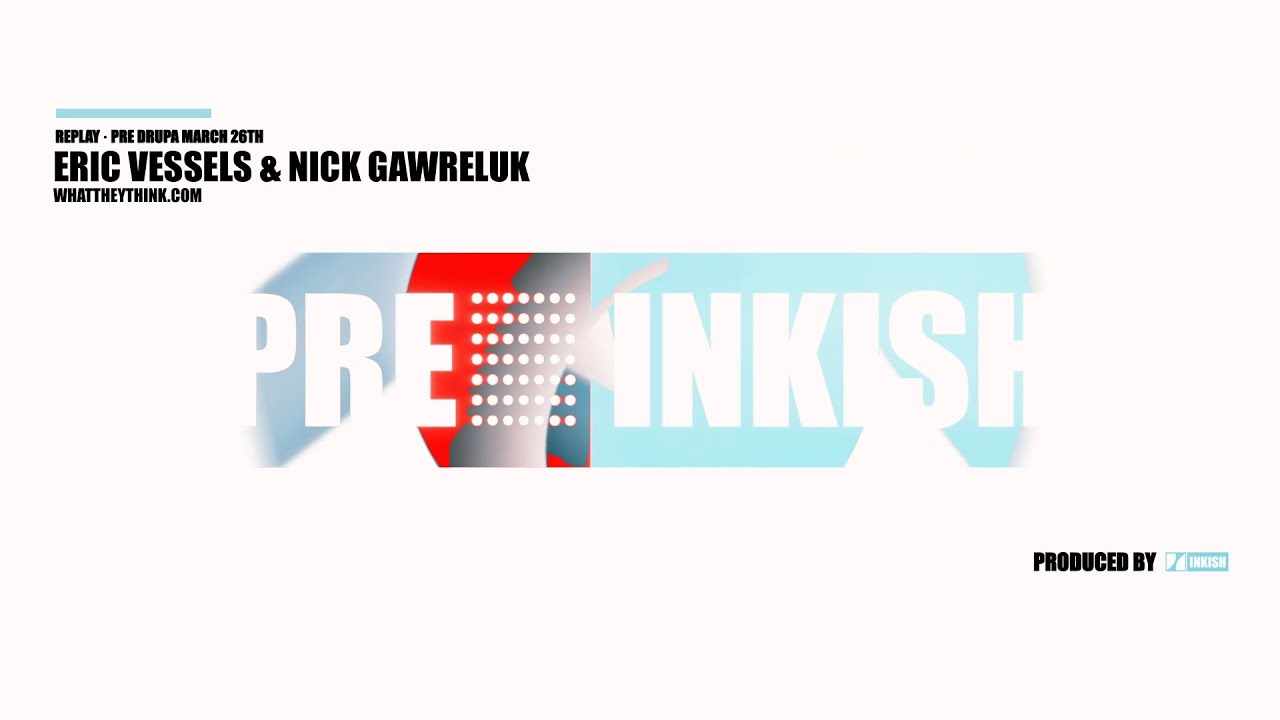At Print Next18 in Stockholm April 25th-26th printers, vendors and even customers met to the bi-annual event – previously covered by INKISH.TV under the name Grakom I/O. This year was a major success with more than 230 attendees – which is a record for the organizer Grafkom.
On the 26th the morning session was conducted by INKISH editor Morten Reitoft who gave a speech on the topic “Do Customers demand web-to-print?”
See the full speech here – and feel free to suggest, comment and of course just listen, if you like.
We’re going to talk about web-to-print. My headline for this one is “Do your customers demand web-to-print?” Because that is the question that we need to ask.
How many here thinks that the customer actually is asking for web-to-print? One, two, three. So I’m just asking this question, if I’m a brand owner or a buyer of print, I would actually guess that my key element for going into a website to buy print is not because it’s a web-to-print solution, it’s because I need a printed product.
If we forget that, sometimes in our way of communicating with ourself when we make the decisions on buying a web-to-print solution or being a web-to-print supplier, that actually puts a lot of effort and difference. Because if we think that it’s important to have a system that can do the web-to-print, maybe we forget that the angle of the nozzle maybe should be different, right? I spoke to Jens from Power Init yesterday evening and I totally acknowledge that there’s a lot of customers that their bids and tenders demand a web-to-print.
I think that a lot of public customers, governments and customers, they like or have liked a demand that there should be a web-to-print solution. But why is it? I think that to some extent this is because everybody think that self-service is cheaper.
You can order any time of the day. But web-to-print is merely just a platform. So it doesn’t really necessarily mean that it has to be cheap because it’s online. But we have in our mindset, we have started to recognize that web-to-print is equal to cheap. But that is maybe not the case.
Then another thing that we also have to speculate about, if we are going into this area, are we still a printing company or are we becoming an IT company? Because the people that works in our companies, we used to have pre-press people, and printers, and maybe designers, and project managers, things like that. But in the future, if you are … Maybe you should have customer service that asks, “How do I integrate my web-to-print solution with your purchasing system?”
Or as, for example, Laser Tryk has done as you know, “How can we trade a white label solution?” Is that typical challenges that we see in our normal printing companies? I don’t think so. So that will require a new mindset on what kind of people we employ, and it will also require new mindset for where we are taking our companies in the future.
I will come in into this in a little bit later, also in this presentation here. The agenda today is we’re going to talk about customers, market, competitors, interfaces, products and production, and prices. And I would take it in that sequence.
So now you can plan your sleeping during the show. So who are the customers and how do they buy? Some of the consumers, some of customers, they are Mr. and Mrs. Jones. They are the ones that buy photo mocks, the-shirts, photo books, all these kind of things that are typical one-offs.
Typically something that has been seen as product that is like the German CEWE. Some are young; some are old. Some are experienced and some are inexperienced. Some has never tried web-to-print before.
In Japanese, actually some also asked for jobs in all languages. Some are professionals and some are not. So requesting that you should ask when we talk about the customers. This is not conclusive.
There’s probably a lot of types of customers. But just with these few examples, I guess that most can see that it’s difficult to actually think that you should be able to make one web-to-print solution, that can cover all the customer types that you’re trying to reach for. So that means that you can have different interface as how you actually interact with the customers.
If you are professional purchases, maybe your interface is different from being Mr. and Mrs. Jones or what you have to consider if you start up a web-to-print solution and are you selling it only locally or you’re selling globally? Those kind of things is something that we need to ask ourself if we go into this business area.
How do they buy? Before we go into how they buy online, let’s say that okay, we have a request for quotation. Guess this is something that most of us can recognize and we have a clarification, was the offer right or did you understand the RFQ. Then we make an offer.
The offer will probably be compared by somebody. Then it hopefully turns into order, and we have some files and we have a proof, then we have shipping, then we have invoice, then we have payment. I guess that most of us can recognize that this is a typical kind of flow in an order process in a company like most printing companies.
If it’s an online, pay attention to this one. Very, very often, it starts with a payment. Because the customer have already selected the product. They have already made the decision about what paper, what size, what colors, whatever.
Whatever you put on your website, they have already made that decision. So it starts with payment. Then it’s an order, files, online proofing, and shipping. So the processes in this one is much easier.
I think that if you are from Southern Europe or Arab speaking countries, then you are very used to bargain about your products, right? I think that one of the advantages will, which is also a disadvantage and I will touch upon that in a moment, is that if you see something online, you find and maybe attracted to price-wise, you buy it. If you don’t like it, you find another website with a similar product and then you buy there.
Because the thing here is that the reason why we consider web-to-print, buying online, cheaper than to do it from offline, is also because of the process. In this flow here, there’s actually a lot of process, a lot of people involved in it. People costs money, right? Processes costs money.
Actually when you pay, most printing companies actually deliver on an invoice, so you also have a financing credit risk, which you also have to take into consideration. So just the fact that you don’t have to take that credit risk into consideration, can make this product cheaper. Or make your profit higher, right?
I’m just trying to give some ideas to think about. This is not conclusive. When I tried to give speeches it’s that I am self-proclaimed Mr. Know-It-All. Doesn’t mean that every- Anything that I’m saying is conclusive.
But my agenda today is actually to make sure that every time somebody is considering investing in web-to-print, start asking the questions that you need to ask yourself. Because everybody can buy web-to-print solution for $300, $400 a month.
But that doesn’t in itself, doesn’t make you successful. There’s a lot of other things, like the marketing thing as you mentioned. And a lot of things as well.
The markets, I … The market is … You can define the markets in a lot of different ways. I’m writing a book right now about web-to-print, and I was actually supposed to have it finished by today so I could give one copy to you, but I didn’t manage to do that.
But I defined three different market segments that I find interesting to talk to, which as far as I can see cover pretty much all the kind of web-to-print solutions. Business to consumer, Vistaprint is an example. Business to business. [foreign language o0:08:49] is an example for that.
Service market, [foreign language 00:08:53], they get a lot of data inside electronically. Is it a web-to-print solution? No, it’s not considered as a web-to-print solution. But it is a transactional kind of distribution of data that turns out to something in print. So I guess that this actually in many ways cover a lot of the different ways of doing things.
Let’s talk a little bit about the competitors. I think one of the biggest threats to your own competition is yourself. Because when I started asking, “Are you a printing company or are you IT company?” To make a decision turning yourself and your own business from being a typical printer to be a typical online printer, or to be typical something else, is in my opinion quite a challenge, which is something that really takes a lot of consideration.
You also have to ask yourself when you talk about web-to-print, do you do it because you want to increase your revenue and your profit? Or do you do it because the machinery is not used enough. If you had the first agenda, then really doesn’t matter where it’s printed, because it’s just the matter of making profit on what you’re selling.
But if you are only there because you have an offset printing press that is not used enough, then that approach might be different. I’m not saying that anything is right or wrong in this one. I’m just trying to explain that you have to make up for your own mind, how you want to work on yourself, and that is a challenge.
My company, we have been giving a lot of … Helping people about requirements for buying web-to-print solutions. The first thing is the owners says, “I know my company good enough. I can make a description of what I need, and then they start working on it.” They forgot maybe … They get snow blind.
I guess that all of us gets snow blinded when we are looking too much at our own business in the longer time we’ve been there, we see the obvious things. We forget to see the things that maybe in a relation to this kind of work is truly important. Of course, also all online printers are competitor to you, because I think that one of the things that we like and we don’t like is that the prices online is very transparent.
I guess that I can tell you how it’s in Denmark. It’s like for years I would estimate that 50, 60, 70 percent of all printers, they don’t calculate their prices anymore. They just go to LaserTryk.dk and take the price they have and hope they can produce it cheaper themselves. Isn’t that crazy?
So the transparency of especially on commodity products makes it very, very difficult, because you need to think about the volume you need in order to print cheap, because everybody can print cheap if they want to. Then I’ve found a great work, and non-line printers. I don’t even know if it’s spelled correctly, but that doesn’t really matter.
The thing about non-line printers or offline printers is basically that the more commoditized products become the higher value, the specialized products are. So if you are looking at it from a competitor perspective. Let’s say that, for example, you have a printer here in Sweden, Gothenburg printer, Göteborg Tryckeriet. I don’t know them, but I know that they had a record … They’re recognized as very good, have won several prizes for being one of the best printers in Sweden.
Some of the work I have seen is just beauty. Can you imagine what happened to their brand? To their product? If they started to sell white label solution from Laser Tryk?
I’m not talking against Laser Tryk’s white label solution. I’m not talking against commodity product. I’m just saying that for non-line printers, you cannot mix those things, because it will for the consumers, it will be … I mean it’s like going into a Bentley car shop, and then they have on the side, they have a secondhand Fiat from 1974 there.
It will be kind of a strange situation to actually experience I guess. Then I have … I couldn’t find one word for it. So it actually continues somewhere out here. So it’s companies who don’t see print as a product. Can you imagine what that is?
That is for example- I will show you in a second, yeah. But that is basically companies that produce … Two years ago here at Grafkom I/O there was a startup company that was actually selling maps. So you could … When you went into the website, and then you entered your address, and then you could choose from different styles of a map, and then they were printed and sent to you, so you could put it on your wall.
They didn’t consider themselves as a printing company. They are not a printing company, but they sell a lot of print. So sometimes we are competing, because we can … I mean all of us can produce anything. I’m not saying that we can produce everything cheap or profitable or anything like that, but everybody who has a printing machine in a bindery can print anything. You agree on that one?
So that leads me to the interfaces. I don’t hope you think this is boring. I’m just trying to give you my thoughts and my considerations about this. See, we have … Most of us when we talk about web-to-print, we talk about worldwide web or WWW, and then we have WWW whatever print.
This I guess, this is where most printers are looking into actually about web-to-print. I also know that both in Sweden and Norway and yes, Sweden and Norway, there’s developers of wet solutions. I guess that most of them are focusing on this one.
Because this is where you see a Vistaprint, you like the idea that you get millions of customers like this. Then you buy this one. Because this is the very, very visible understanding of what web-to-print is.
But there’s also a new market. A lot of people is talking about how the mobile phone, the smartphone is actually the driver of a lot of different businesses. All of us we have a smartphone, and I don’t know if you consider this, but sometimes when I take my phone, I just say that, okay, use it as a calendar. I use it as a web browser. I use it as a mail program. I use it as whatever application I use.
It’s just amazing. Because you have a small computer, but because the screen is small, you can either use a website on it. But a lot of us is downloading apps and some of the apps are also interfaces for how to sell print. Because what is print? Print is … Essentially it’s a lot of photos or pictures, and a lot of text basically.
In this time we are living right now with Instagram and social media, a lot of our communication is visual. So if you have, I don’t know about your phone. I think that my phone carries around 17,000 photos or even more. So if I want to make a greeting card for my mom or whatever, I just click, click, click, boom. Then I have a file. I don’t need a design. I don’t need anything like that.
So the apps is actually a … In my opinion a very important way also to interface with the customers. Then we have the APIs. Do you know the APIs? The APIs is … So here we connect with people. The APIs connect with computers.
I would like to show you something here. So I just go to … If I’m able to do that. This is a website called programmable web. Programmable web, it has a list of APIs that are related to print.
So this is basically either companies that only provide the APIs or printing companies that provide interfacing directly into their workflow systems. So rather than buying a web-to-print solution that is ready made, you can actually consider to actually develop something where you don’t need a printing machine. You don’t need a specific web-to-print solution.
You just need a program that is able to take the API and turn it into business, where you can facilitate print in many different ways, and some of them are very, very capable. For example, Amazon Prime. It’s a huge, huge, huge printing company. They have a long list of APIs that can actually integrate into various kinds of the value chain.
Another very, very big player in this market is Cimpress, Vistaprint. I think they have more than 200 APIs for their services. So if you want to make an app for sharing photos or printing photos, you can do that without buying a specific thin. You can buy something and you can use the services for free.
Also quotation for free, because the free part of this is basically that they sell print so they have a margin on the print, but they sell the print cheaper than many of us is able to produce. Because they have an enormous volume, and that is something that is pretty fantastic basically. Let’s take a look at some of the WWWs.
This is Saxo Print. You know Saxo Print? You know that it was owned by CEWE? The photobook, Europe’s biggest photobook creator? This company or this family of companies, they turnover €600,000,000 a year in print.
You know Hello Print? No. Hello Print is from Holland. It’s in family build online printers. You know anybody else that is family build online printers? Laser Tryk in Scandinavia for one. They have an incredible pace of working right now.
The reason why I’m showcasing these two is because Saxo Print, I thought it was funny. Maybe I don’t get it, but Hello Don’t Print. Because this is a printing company. This is a broker.
So these two types of company for the costumers, they will be perceived the same way. They sell print. They are focusing a lot on commodity products. So if you’re looking for letterheads, business cards, leaflets, folders, brochures, the simple kind of stuff, that is typically you’d have unbranded paper stock.
You have different service levels on delivery time. So you can decide. Do I want the really cheap one? Maybe wait eight days for it. Or do I want the overnight thing?
For example, online printers in Germany. They have for most of the print, print product whatever volume you’re asking for, they actually deliver within the same day in Germany when you order. Which is just crazy. How many in Sweden deliver same day? I’m not talking about 100 business cards around the coffee shop. I’m talking about maybe 15,000 catalogs from day to day.
I can give you an example. I had … We are a print broker in Denmark as well, as some of you may know. We had a project that we purchased, 1,564-page catalog from Latvia. Good price, good quality. The problem was that the binding was not right. They misunderstood what we wrote.
Again, if you remember back to the first process about … All the processes we need to go through. That was a new customer for me, so I had to do something about it. So I called Laser Tryk, and I said … That was one o’clock in the afternoon. I said, “I have 1,500 catalogs. I have 64 pages on 870 gsm silk. I must have it in Copenhagen tomorrow.” They delivered to Copenhagen the day after, for almost the same price as the Latvian printer.
Isn’t that crazy? So the competition is pretty fierce here. I spoke about different apps. These guys, are they a printing company? Is this? Do you know them?
You know that one, right? Yeah, basically they had made an app, take some photos. This is my son’s. Then I sure have trimmed it, picked a frame, pretty easy, access to all my photos.
What they actually do with this one is that they have on demand postcard production that actually print this product, put a postage on it and deliver it to my mom. I think I put my mom on it. So it’s just an example. Yeah.
The reason why Postnord is doing this is not because they are a printing company. They might not even print this themselves. Maybe they have an app where they have an API connecting to some printers that they work with who prints this and put all of them in the postbox to make sure that it’s shipped out.
The price for postcard, including postage is 19 Danish krone. If I go to a tourist shop in Denmark and buy a nice postcard, I would guess that it would cost around 19, 20 krone without stamp. So this is just like business model that either we have to connect with them in order to make sure that we can print their products, or we have to use the same kind of service, because we can turn it around and use that as well.
Printic is a French company. I like them a lot. Actually it’s stupid simple product. I’m sorry that the resolution is not so good here in the screen. But they had made a simple small box and that box has … I think t’s eight by 10 or something like that. Then you just pick 50 photos of your library. Click, and then you get a little nice pre-made box with 50 print in it, and you pay … I think it’s about €18 you pay for that, including shipping.
You may think yet … Just imagine if you have eight by 10. Let’s say that you have a B2 sheet digital. I have not checked, but in my opinion, it’s probably one sheet they put in it. So one sheet, trim it, put in the box, send it out.
How much does one sheet cost? Does it cost less than a Euro? I guarantee that’s less than a Euro. So they have a margin that is I guess much higher than if we were selling in the old times. We were selling an entire process of business cards and a lot of processes. The APIs, I just found two. There’s hundreds of them.
The interesting part of this one, called Kite.ly. That is owned by Canon. So why is Canon interested in having API and web-to-print integration? I guess that Canon’s major revenue is click based. Of course they like to sell machines, but I guess that a lot of you guys working in digital print like to get volumes and clicks.
So if they can give customers and developers an easy access to this kind of services, I guess Canon can actually gain revenue by making sure that their customers make more money on these kind of things. I just wanted to show you these kind of things, because remember when we started, I was asking, “Are you here because you want to fill up your own machine? Or are you here because you want to make money and sell products and services?” If you want to sell a lot of print, sometimes developing and API and go and interface with a lot of these new startups and other printing companies, maybe it’s more interesting. Maybe the return of investment is much higher. I’m not sure.
Then you have the products. I promised to tell you what kind of products. You can see that you can decide for yourself. Web-to-print is not … Doesn’t have to be commodity product. You can sell anything online if you are good enough with the interface, user interface.
So you have to decide. Do you want to sell commodity products? If you want to sell commodity products, you are in a highly competitive market. You’re communicating and talking and selling to a lot of people that are really not loyal to you. They will buy anything that is the cheapest possible.
If you have specialized products. Let’s say Moo. You know Moo with the business cards? Or Elegante Press from Lithuania making sales letterpress products or CEWE who’s doing photo books? Versus Print24, Online Printers, Flyer Lab, and many, many, many more selling commodity products. Different business models.
Some of the terms that you need to get used to is automation, ganging, marginal cost rather than full-cost, which is a terrible problem if you’re buying a new printing press, because we are used to do the absorption cost for that. Something like dropshipping.
You know what dropshipping is? They have orders. They buy some. People that buy something from you, and ask it to be delivered neutral to somebody else? You can’t imagine how difficult that is for many printers. It is really difficult for them.
API, just spoke a little bit about it. You need to take that in consideration. Mergers and acquisitions is the new agenda for things, because you may also start up having a web-to-print solution. Being an online printer, because you have decided basically to sell your company, so you have an exit strategy, rather than having an operational strategy.
The democratization of prices. You know what that means? That means that the prices are lower, lower, lower, reaching a marginal price. Let me show you how difficult that is. In America, they are so fortunate now to have the company called Free Prints. They offer every customer that register 1,000 free photo prints a month for free, only pay for shipping.
A couple of months ago, they introduced now free photo books. So you get one photo book a month for free, only pay for shipping. I think the shipping price for the photo book was 7.99 in dollars in the US. Do they do it because they are advertising driven? They do it because they have so large volume, so the shipping cost they have is marginal to whatever they sell. So they make the profit actually on the surplus of the shipping cost.
So that is something that really make a lot of changes in our industry. As always to end my presentation, of course, should find a lot of inspiration. We have been working with Ola, Ulf, and Magnus. But also the Grafiska Företagen, often referring to very, very brilliant presentation they did.
So that is good. We have also more than 10 films on Inkish.tv about web-to-print where different suppliers is talking about the service and offering. So thank you very much.
































